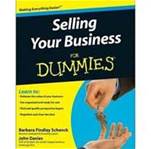
Of all the factors that affect the sale readiness of your business, its financial condition tops the list. It-s difficult to look attractive to a prospective buyer unless you can showcase a good financial history with growing revenues and earnings, all documented in well-presented financial records
Your business may keep financial records in the form of a balance sheet and income statement that tracks sales cost of sales expenses and profits. More likely, especially if yours is a business on the small end of the spectrum you may operate from a cash flow statement tracking your business health by watching changes in your cash position. Working from either set of records, you must be ready to show prospective buyers how over the past few years your business has grown its top line (its sales) and its bottom line (the amount that remains as earnings after expenses are covered). This recent financial history and how neatly it’s chronicled in financial statements is what you want to evaluate before exposing the finances of your business to the masses.
The reason buyers want to see your financial history is simple. How your business has performed financially in the recent past is the best indicator they can get of how its going to do in the near future. In other words, buyers want to study past financial statements in order to assess future business potential.
As you consider the financial condition and potential of your business, be realistic and base your growth projections on sound credible forecasts that are well justified by actual recent financial performance. Do not even think about stating or hinting that your business makes additional money under the table or off the books. To a prospective buyer the reddest flag of all is a price that the owner says is justified by money generated from off-the-books revenue. If an owner makes such a statement, the underlying message is “Trust me” however by making the statement, the owner essentially admits to dishonesty scaring honest buyers off as a result.
Assessing the financial condition of your business
After reviewing your sales and profit growth trends and other financial records, a buyer will slot your business in to one of the following categories:
• Growing revenues and earnings:
A business that’s attractive from a financial standpoint will have sales and gross profit lines on a similar incline, indicating that revenue is growing and the at the business is managing its cost of sales well. Further, the business will generate enough gross profit to pay operating costs and have enough left over to provide an attractive income for the owner. Most buyers desire to see a favorable earnings figure. If such is the case with your business, it is probably a good and ready sale prospect, if the operations, transferability, and sale terms are also attractive.
• Growing revenues but declining earnings:
If sales are growing but your bottom line is shrinking, a buyer will look for one of two culprits. First, cost of sales may be out of control, absorbing sales revenue before it can even make it to the gross profit line. Second, the cost of running your business may be out of control. If either of these conditions leads to a weak bottom line, you have some remedial work to do. On the other hand, if your bottom line is minimal for the good reason that you have expensed owner and discretionary business expenses to keep taxable income down, preparation of a seller’s discretionary income statement, will factor non-essential costs back into your bottom line and show the strength of how much your business actually earns for its owner.
• Moderate-to-serious growth challenges
If your top line is declining or dipping up and down, a buyer will see a business with erratic sales, probably due to a product that’s poorly accepted in its market, weak marketing programs, or other problems that lead to poor or uneven sales. To position your business as a good sale prospect, you want to improve your growth trend to show steadily increasing sales.
• Faced with solvency issues
Businesses that owe more than they own, and businesses that cannot pay their cost of sales and essential operating expenses without eating up all their sales revenue and maybe more, face critical financial problems that scare off most prospective buyers. If your current liabilities are greater than your current assets, your business is either insolvent or close to it. Your options are to rapidly decrease debt and build assets, to try to sell at a discounted price to someone who sees value in your product or operations in spite of your financial problems, or to liquidate assets and close before incurring further financial risk.
** from the book Sell a Business for Dummies by Barbara Findlay Schenck, Business Advisor & Sunbelt’s CEO John Davies
About Sunbelt Business Advisors
Sunbelt Business Advisors is an elite division of Sunbelt, the largest organization of business brokers and M & A professionals in the world. With five offices in Minneapolis, Minnesota; Chicago, Illinois; and Milwaukee, Wisconsin, Sunbelt Business Advisors is a premier brokerage. The business brokers and M & A intermediaries of Sunbelt Business Advisors, consistently rank in the top performers of Sunbelt International. Because of this team’s expertise, it has been trusted with coordinating all of the national franchisor relationships for Sunbelt. Because of this interaction, Sunbelt Business Advisors has a unique ability to market businesses throughout Sunbelt internationally. Sunbelt truly has GLOBAL reach!




